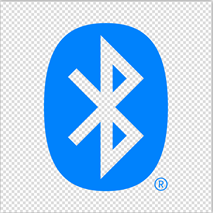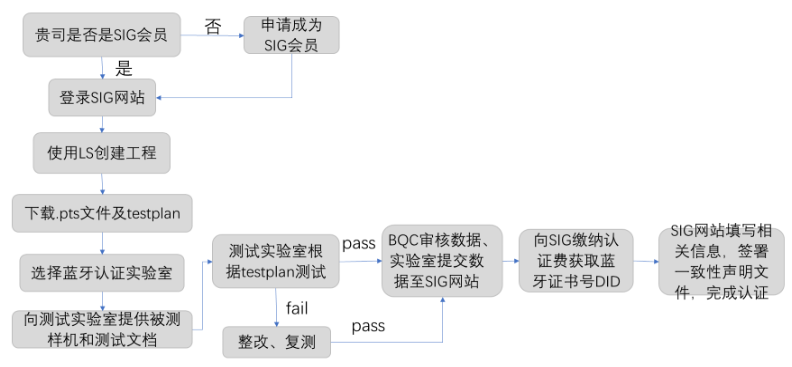
| Certification Type: | Voluntary |
| Certificate Validity: | No limit |
| Local Testing: | Not required |
| Local Representative: | Not required |
| Marking Requirement: | No |
| Modular Approval: | Allowed |
1. Introduction to the organization
BT SIG stands for Bluetooth Special Interest Group (Bluetooth Special Interest Group) and its website address is www.Bluetooth.com.
Founded in 1998, SIG is a global technology exchange organization with more than 36,000 companies participating, a private, not-for-profit alliance dedicated to unifying, harmonizing, and driving innovation across a wide range of device links, and by collectively creating and sharing technology standards, Bluetooth ® technology simplifies, secures, and enriches the technology experience for users around the world. The alliance has the right to develop Bluetooth trademarks and standards, and all Bluetooth® core specifications, application specifications, and test specifications are formulated by the SIG Alliance, and have complete intellectual property rights. Its main work includes: publishing Bluetooth standards, managing certification procedures, protecting Bluetooth trademarks, and promoting Bluetooth technology.
2. The necessity and significance of Bluetooth certification
- Bluetooth intellectual property license can be obtained, otherwise it is infringement;
- Allows products and designs to use Bluetooth logos, otherwise Bluetooth logos cannot be used;
- Fully verifies that the device conforms to the Bluetooth specification;
- Improve interoperability between Bluetooth products;
- Increase the popularity of Bluetooth technology.
3. Bluetooth SIG membership types and benefits
To become a Bluetooth SIG member, a company must apply for membership, enter into a membership agreement, and agree to be bound by the relevant documents of the SIG company.
Adopter: Free to apply and register
Associate: Paid membership for the following fees (associate can only be applied after becoming an adopter).
Companies with annual revenues of more than $100 million have a membership fee of $35,000
Companies with annual revenues of less than $100 million have a membership fee of $7,500
| The membership type corresponds to the rights and interests | Adopter | Associate |
| Bluetooth technology is used in the product | Y | Y |
| The Bluetooth trademark and the LOGO | Y | Y |
| Available Draft specification versions | V0.9 | V0.5, V0.7, and V0.9 |
| Use the PTS testing software | Y | Y |
| View the Bluetooth Brand Equity Survey | N | Y |
| View the market research report | N | Y |
| fees and corresponding discounts | ||
| DID purchase fee is | $8,000 | $4,000 |
| In the Bluetooth SIG specification, the IrDA specification is | 12.5% | 50% |
| Ellisys protocol analyzers | not available | 25%-50%. |
| Teledyne LeCroy Protocol Analyzer | not available | 25%-50%. |
| Technology influence | ||
| Participate in the study group and the expert group | Y | Y |
| Participation in committees and working groups | N | Y |
| Elected as Chair of the Committee and Working Group | N | Y |
4. Instructions for using Bluetooth Logo
Under the Bluetooth Trademark License Agreement (BTLA), only members of the Bluetooth Special Interest Group ("Bluetooth SIG") have the right to use the Bluetooth word mark, figurative mark and combination of marks (collectively, the "Bluetooth Marks"). Applicant companies are required to agree to all agreements during the membership application process, one of which is the Bluetooth Trademark License Agreement, which sets out the terms and conditions of use of the Bluetooth trademark. Only Bluetooth SIG member companies may use the Bluetooth trademarks on their eligible products under the terms of the Bluetooth Trademark License Agreement. Members may use the Bluetooth Trademark for their products and services, as well as for the Company to promote its Bluetooth technology or affiliateship in the Alliance. When a trademark is used in conjunction with a product, the product must have undergone and completed the Bluetooth certification process.

5. SIG Authentication Method:
SIG certifications are divided into two categories: those that require testing and those that do not require testing.
Situation and process that do not need to be tested:
- Certified product uses a qualified Bluetooth product (EndProduct/Subsystem) from another member company and does not change or add Bluetooth functionality
- Purchase a product manufactured by a third party and re-label it with the company's name or logo;
- New product certification is designed only to obtain the certified subsystem or endproduct, and no changes are made to the design during the assembly process.
STEP:
- Fill in the basic information of the project, including the project name and reference, the QDID
- Provide product information that needs to complete the certification,
- Pay the DID fee
- Submit the listing
Situation and process that needs to be tested:
- New Design: A new Bluetooth design
STEP:
1.Fill in the basic information of the project
2.Select the relevant layers supported by the product
3.Select ICS information
4.Generate testplan
5. Submit test reports and records
6.Provide the product information that needs to be certified
7. Pay the DID fee
8.Submit listing information

Figure: NEW DESIGN certification process
6. SIG certified product categories (divided into 5 categories).
End Product: a product that supports host+controller, and optionally supports Profiles and services
Subsystem: Divided into host subsystem (optionally supports Profiles and services) and profile subsystem (must support Profiles and services)
Component: There is no layer that must be supported, and it must be converted into an end product or subsystem when used (advantage: all -c case results involved in the component can be inherited, disadvantage: only 3 years validity)
Test Equipment
Development Tool
7. SIG certification test content (including 3 categories).
Radio Frequency Conformance Test (RF):
- BR(Basic Rate)
- EDR (Rate/Enhanced Date Rate)
- LE(Low Energy)
Protocol Conformance Test
- Controller hardware module protocol
- the Host software module protocol
Interoperability test (Profile):
- about 64 profiles based on Bluetooth LE technology
- about 32 profiles of classic traditional Bluetooth technology
8. SIG Certification Cycle
The following table is a summary of the cycle information required for the SIG certification test in the preliminary preparation, formal testing, review and certification stages in combination with the current general situation of our laboratory.
| Phase | Cycle | Customer | Lab |
| Prepare | 1~2 days | determine the test requirements, and provide the basic information table of the sample | |
| 1 day | / | Provide blank PICS document to the customer upon request | |
| 1~5 days | to fill in the PICS form, provide a prototype | ||
| 2~5 days to | correct PICS | create a Test Plan, feedback to customers on PICS problems found during the creation process, and complete the Testplan | |
| Formal testing | 7 days | / | start the test |
| Debug | regularly provides feedback on test progress and issues | ||
| / | End of test | ||
| 1 day | / | test report issued | |
| Review project | takes 1 day | / | the project is submitted to BQC for review |
| 2~3 days | to confirm and correct the feedback problem | BQC audit project, problem feedback | |
| 1 day | / | project to pass the review | |
| Obtaining the certificate | 1~N days | obtain the DID number | can be carried out simultaneously with the test |
| Obtain the certificate | listing and download the certificate |